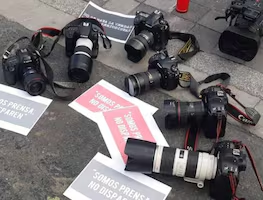Más Información

Noroña informará a Sheinbaum del despido de mil trabajadores en Oaxaca; Gobierno acusa que plazas fueron ilegales

Artículo 19 teme por la integridad de periodistas en EU; Trump amenazó con represalias por coberturas negativas

Sheinbaum y Lula sostiene llamada telefónica; “vamos a fortalecer relaciones culturales y educativas”, informan
In the heartland of the tequila industry , in Mexico’s western state of Jalisco , a worsening shortage of agave caused by mounting global demand for the liquor from New York to Tokyo has many producers worried.
The price of Agave tequilana , the blue-tinged, spiky-leaved succulent used to make the alcoholic drink, has risen six-fold in the past two years, squeezing smaller distillers’ margins and leading to concerns that shortages could hit even the larger players.
In front of a huge metal oven that cooks agave for tequila, one jimador —a type of Mexican farmer who harvests agave plants, which are harvested primarily for the production of mezcal, sotol, and tequila—near the town of Amatitán said he had been forced to use young plants to compensate for the shortage of fully grown agave, which take seven to eight years to reach maturity.
He asked not to be identified because he did not want his clients to know he was using immature plants .
The younger plants produce less tequila , meaning more plants have to be pulled up early from a limited supply-creating a downward spiral.
“They are using four-year-old plants because there aren’t any others. I can guarantee it because I have sold them,” said Marco Polo Magdaleno , a worried grower in Guanajuato, one of the states allowed to produce tequila according to strict denomination of origin rules.
More than a dozen tequila industry experts have said that the early harvesting will mean the shortage is even worse in 2018 .
Already, the 17.7 million blue agaves planted in 2011 in Mexico for use this year fall far short of the 42 million the industry needs to supply 140 registered companies , according to figures from the Tequila Regulatory Council ( CRT ) and the National Tequila Industry Chamber ( CNIT ).
The shortages are likely to continue until 2021
, as improved planting strategies take years to bear fruit, according to producers.
The result is agave prices at MXN$ 22 ( USD$1.18 ) per kilo - up from MXN$ 3.85 in 2016 .
Those higher prices mean that low-cost tequila producers , which make a cheaper, less pure drink that once dominated the market, find it harder to compete with premium players.
“It doesn’t make sense for tequila to be a cheap drink because agave requires a big investment,” said Luis Velasco , CNIT’s President .
Small-scale distillers of quality tequilas are also feeling the pinch and some warn that drinkers are seeking alternative tipples.
“At more than 20 pesos per kilo, it’s impossible to compete with other spirits like vodka and whiskey,” said Salvador Rosales , manager of smaller producer Tequila Cascahuín , in El Arenal , a rural town in Jalisco.
“If we continue like this a lot of companies will disappear,” he said.
Exports to the United States of pure tequila jumped by 198% over the past decade, while cheaper blended tequila exports rose by just 11% , CNIT data shows.
Over the same time, Mexican production declined 4% , with blended tequila leading the fall.
sg







